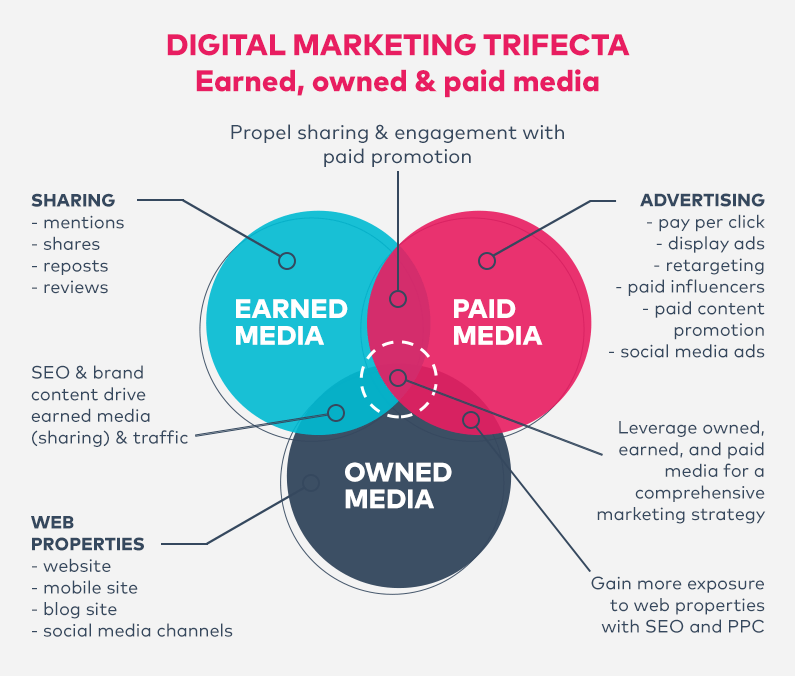Trifecta of Digital Marketing: Owned, Earned, and Paid Media
Let’s imagine the internet as a large pool of created and shared content originating from all sorts of different sources. This content body is segmented according to various criteria, which is sometimes done successfully and at other times, not so much.
The key questions that arise are as follows. What is truly ours here? What did we earn with a good online approach, and what do we pay for in order to make our story visible to others? These distinctions are the focal point of Digital Marketing Trifecta, a concept that has a profound impact on your digital strategy and approach.
In case you need support with setting up the right digital marketing strategy, contact us.
Two Sides of the Content Medal
For starters, it’s essential to realize that in general, activities on the internet and its digital avenues can be divided into two significant parts. The first one would be content creation. It includes the processes of building web properties: websites, apps, landing pages, micro-sites, visual solutions, as well as crafting and publishing of videos and articles…
Namely, everything you do, be it writing articles, taking photos, recording videos, or developing websites, either brings a piece of content to life or serves as a content vehicle. We distribute all this content via marketing channels we deem suitable to our needs. However, if you don’t engage in other, equally important parts of the story— paid advertising, only a small fraction of your content will be actually seen. This insight does one important thing for us. It helps us understand the content promotion via the internet indispensable.
There are various promotional options we can consider, and most of them lean toward social media. But, we need to recall right away that Facebook, Instagram, LinkedIn, and Google are commercial platforms in nature. They give away something for free very rarely or spoon-feed it carefully. On exception to this established pattern would be Google’s recent $800 million aid package to small businesses that are struggling during the Pandemic. In any event, it’s challenging to get anything done without investing in promotion properly. A decade ago, we could create a story for free and spread it around fast. Nowadays, platforms put a set of limitations before us, obstacles we can usually overcome by money.
Thus, it’s imperative to get smart with promotion and pay close attention to all the resources that stand at our disposal. They come in the form of both standard and advanced marketing tools, such as Google Analytics, Moz, HubSpot, Screaming Frog SEO, and Hootsuite. We also have to take into account a host of moving parts when developing a digital strategy, showcasing our brand, launching campaigns, and organizing our activities. Lastly, it’s necessary to understand why we create content in the first place and how we seek to go about it. Setting SMART goals from the get-go can help us gain a sense of direction and purpose.
The Holy Media Trinity
We come across three major types of content that are tied to different promotional efforts, as well as the digital media real estate you own. We’re talking about owned, earned, and paid media. They are all subsets of the same digital landscape, parts of the big media picture. This picture becomes even more fragmented when we start looking at different marketing channels. Nevertheless, always keep in mind three media types, and related channels are interdependent parts of the same whole.
Having cleared that out, we shall turn our attention to social media. To stand any chance of surviving there, we need to develop a business model and sound digital strategy. After all, these platforms can be rather unforgiving places. On the surface, they resemble traditional media and encourage us to emit paid ads and commit to regularly promoting our published work. They always tell us the best way to earn money is to spend some on ads. If we look back at what marketing used to look like, though, we realize it was always based on the combination of paid, earned, and owned media. Nothing fundamentally changed here.
Facebook did start as a great destination for organic publishing, and in those “olden days”, one could get by without advertising. But, the network has evolved into a huge, powerhouse platform that integrates all types of modern media. Yes, the center stage is reserved for you and the content you create. The ultimate trick, however, is to spend as little money as possible and achieve the best possible result. Understanding Digital Marketing Trifecta holds the key to obtaining these goals.
So, we’ll now examine how all of this looks like with the help of visuals:

Image 1: An overview of digital marketing trifecta
First off, we have earned media, also known as free media, which corresponds to online word of mouth. It’s a type of publicity you neither pay for nor own, as well as content that others (third parties) create about you. Earned media is most often gained with a combo of organic ranking and quality content. The first page of search engines is the dream destination of any earned media tactic, as it grants maximum visibility to your owned media.
Notice as well that earned media practitioners aim to obtain brand mentions via social media, by making good use of posting in particular. Reposting, writing reviews, sharing, liking, sharing, and commenting on published pieces— these actions all make a powerful impression on customers and spread your story around. They can also produce a viral piece, which explodes on social media and gives unparalleled brand exposure.
Next off, pay per click (PPC), display ads, remarketing, influencer marketing, paid content promotion (native advertising), and ads on social media, they all belong to the area of paid media. This is a form of digital advertising that revolves around buying ad space and promoting your property via sponsored deals. It allows you to drive traffic and reach a wider audience than otherwise possible. On the other hand, owned media is web property you control, an asset that is exclusive to your brand. We’re going to cover this facet in more detail in the following section. For now, you should notice owned media properties are essentially online branches of your brand. They are places of consumer interaction and empower you to spread brand awareness far and wide.
Furthermore, we have to underline three media types overlap and intersect in many different ways.
For example, if you have additional sharing or interactions with your paid promotional activity and you manage to amplify the story that way, the part of your paid media turns into earned media. One of your chief goals should thus be to encourage people that come from paid ads to share your story and enter the earned media loop.
Perks of Ownership
So, you want to ask yourself the one-million-dollar question: “What do I really own on the internet”?
Realistically speaking, these are only the media assets that you have full control of. You can count into this category your website, app, blog, newsletter, or forum. There are also “partially (conditionally) owned” media spaces. Channels of communication on social media (accounts, pages, and groups) are among them, and the same goes for any accounts you have on platforms that aren’t in your ownership. You exercise only partial control over there, as you depend on platforms’ real owners in many ways.
There is some overlap and interchange between the media areas. Through paid media, for example, you gain new visitors for your website or blog. They subscribe to your newsletter, like your page, follow you on Instagram, and join your earned or owned media while at it.
The main lesson to draw from these examples is clear. With the help of quality content and relevant target audience, you entice people to share and interact. These activities mark their migration to the earned territory. Again, we can employ paid advertising to send people to the website, where some of them turn into owned media consumers. Finally, SEO and branded content convert earned traffic into owned one. These two tactics enable us to gain more exposure to our web assets and channels.
What Has the COVID-19 Crisis Taught Us?
In the past two months, we witnessed a rise in self-organizing activities.
People create groups on Facebook, initiate partially or conditionally owned channels on social media, and rally around narrow niches. In the US alone, 4.5 million people have joined COVID-19 support groups. It seems that only in times of crisis do we become aware of the incredible power of social media and its ability to freely transmit information without the fear of jeopardizing people’s health and lives. Users are also tempted to launch online stores, and those who already have them are driving record-breaking sales. For instance, purchases for cold, flu, and cough products, as well as toilet paper, have skyrocketed. The e-commerce sector, in general, is doing quite well in the face of disruption.
We also want to point out the data from the field signals that B2B organizations record most sales via newsletter. This is an owned media channel targeted at a very “eager” group. Other B2B channels that surged are video conferencing, web sales, and phone. Experts predict they will all retain a pivotal role even when the Pandemic passes.
Many companies are awakening to the fact that digital transformation is no longer optional, not if they want to stay alive and thrive. Word of mouth (earned media) is still the busiest information highway, and it demonstrates that people have a strong urge to help others. Truth be told, this channel can be haphazard and unruly, meaning we shouldn’t rely solely on it. We think that every social media profile acts as a medium of its own. It’s high time you start treating it as such.
Another crucial thing to remember is that the website is a centrally owned hub that coordinates various activities. You can’t have a robust digital presence without it, but in the current climate, it’s not enough as a stand-alone asset. To foster a fully-fledged digital ecosystem, we have to harness the full potential of all locations that people frequent on the internet. The second component for success is creating content tailored for specific platforms. On Facebook, you want to post videos and curated content. Instagram is a go-to place for stories, photos, and quotes. Twitter is more geared toward news, blog posts, and GIFs. You get the point.
The intersection of all three circles of Digital Marketing Trifecta sends us a clear message: we should take advantage of all means of promotion and utilize them as segments of a comprehensive digital strategy. Make this the principal goal of your marketing strategy, which has to ultimately be centred on people and their needs. If some of them come from paid advertising and interact with your content, their friends will take notice. Not only that but they may follow you on your digital channels of communication and visit your website. Later, having a conversation with them will be much easier. For you, this is nothing short of a win-win scenario.
If you require support in developing your strategy and maximizing Digital Marketing Trifecta, don’t hesitate to contact us.



